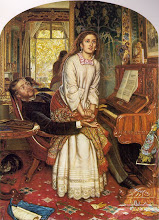
One of the topics of my recently-defended dissertation is the patristic concept of the flux between sin and grace in the human soul (what this has to do with music is best left for another post). Some of the Fathers of the Church symbolized this flux with a hermeneutical pairing of Saint Mary Magdalene with the Mother of God.
The Church began to identify with the Virgin Mary in the twelfth century, but remnants of an earlier tradition remained, a tradition that looked to Saint Mary Magdalene, the penitent sinner, as its herald. An example of this tradition can be found in the commentary Origen (above) wrote on the Song of Songs in the third century. In a detalied exegesis of verses 1:5-14, in which he expounds virtuosically on the dichotomy of light and dark, Origen further suggests the similarity of the Bride to Mary Magdalene:
I am beautiful through penitence and faith . . . she who now says "I am black and beautiful" has not remained in her blackness . . . She became black . . . because she went down, but once she begins to come up . . . she will shine with the enveloping radiance of light . . .
[The bride] has repented of her sins; beauty is the gift conversion has bestowed; that is the reason that she is hymned as beautiful.
Origen thus conflates both the individual soul and the Church with, simultaneously, the sinful woman of Luke 7:36-50 and the bride of Christ -- a bride in need of purification, "black by reason of her sinfulness but comely . . . because of her repentance [and] because she was loved by Christ." The bride's darkness, as Origen construes it, is not a physical trait but a spiritual one, for, though she is penitent, she is not yet wholly purified from her sin.
What's more, according to medieval legend, the Magdalene was herself a bride -- the bride at the wedding at Cana where Christ performed his first miracle (John 2:1-11); and her bridegroom was none other than Saint John the Evangelist, who, upon witnessing the apotheosis of Christ's divinity in the miracle of the wine, abandoned his bride to become the Beloved Disciple. In anger, Mary Magdalene embarked upon a life of carnality, until, encountering Christ herself, she was called to conversion, and eventually, through years of penance, rose from the depths of sin to the height of heavenly glory.
As Pope Paul VI noted in Lumen Gentium, the Church, "clasping sinners to her bosom, [is] at once holy and always in need of purification, [and] follows constantly the path of penance and conversion."
And as Bob Dylan says in the song "Ring Them Bells": "Time is running backwards, and so is the Bride."
During this season of Advent, when we, in all senses, step outside of ordinary time, may we reflect on these mysteries and seek to be truly converted ourselves.











No comments:
Post a Comment